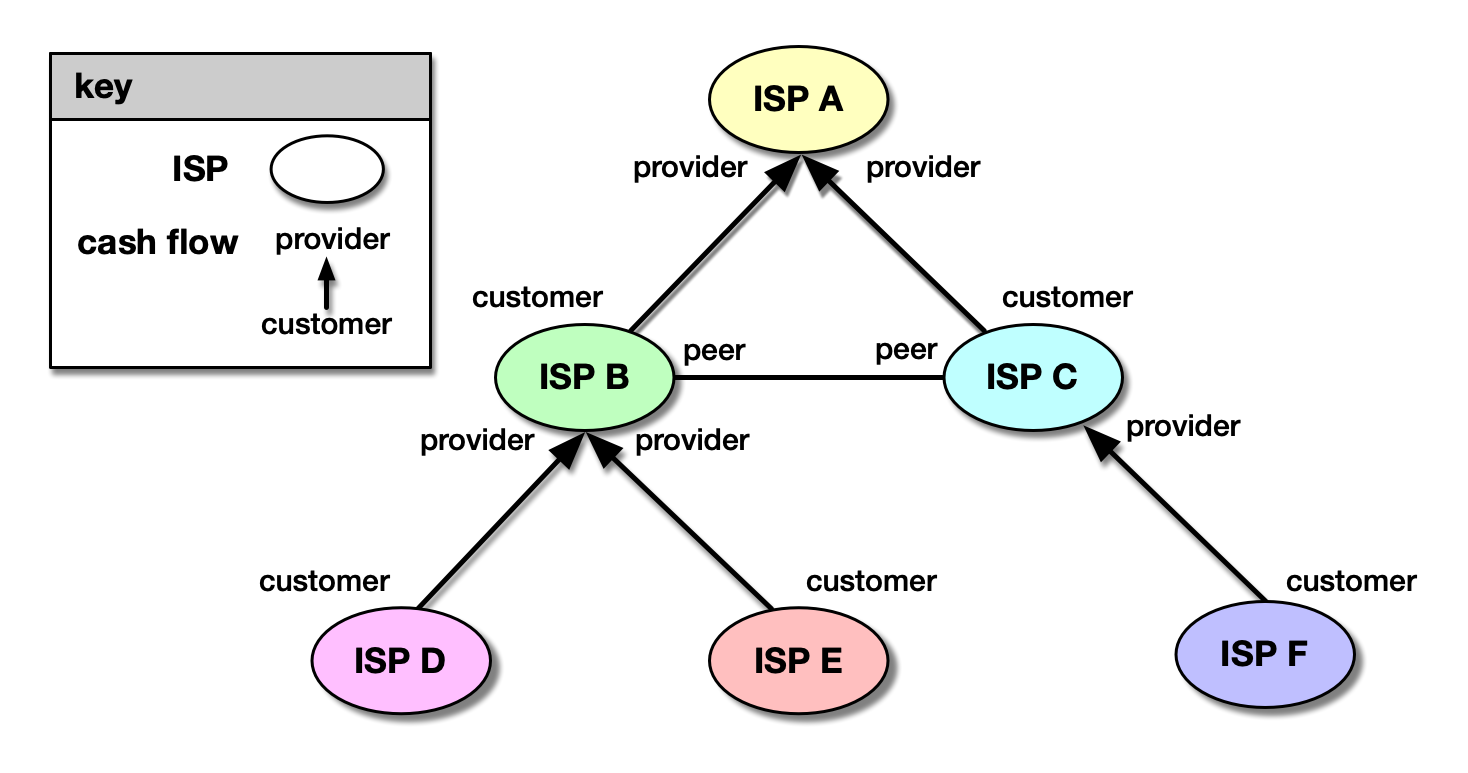Background
The AS Reach Visualizations provides a geographic breakdown of the number of ASes reachable through different types of neighbors of the specified AS: customer, peers, providers, or an unknown neighbor. Independent networks (Autonomous Systems, or ASes) engage in typically voluntary bilateral interconnection ("peering") agreements to provide reachability to each other for some subset of the Internet. Although these business agreements between ASes can be complicated, the original model introduced by Gao et al. [1] abstracts business relationships into the following three most common types:

Figure 1. Types of AS relationships. The ASes at the bottom of the graph, D, E, and F, are customers of those above. ISPs in the middle (B and C) are providers of ASes below and customers of ISPs above. ISPs B and C are also peers of each other. ISP A at the top is a provider to B and C and a customer of no one.
- customer-to provider: in which a customer network gets access to the Internet from a provider network
- provider-to-customer: the reverse of the customer-to-provider, the provider provides access to its customer
- peer-to-peer: where both ASes exchange traffic between their customers
The justification for this classification is that an AS must buy transit services for any traffic destined to parts of the Internet that this AS neither operates nor can reach through its customers. In Figure 1, arrow directions reflect flows of money -- ASes at lower levels are customers who pay ISPs (providers) at higher levels in exchange for access to the rest of the Internet, also known as transit. We refer to links between a customer and a provider as c2p (p2c) links. In Figure 1, D->B, E->B, F->C, B->A, and C->A are c2p links.
A p2p link connects two ISPs who have agreed to exchange traffic on a quid pro quo basis. Peers should exchange traffic only between each other and each other's customers. Peering allows growing ISPs to save money on transit costs they would otherwise have to pay to deliver traffic to/from their customers. In Figure 1, B-C is a p2p link, unidirectional since neither B nor C pays the other for the traffic they exchange.
AS Customer Cone
Given these relationships we can define AS A's AS customer cone as AS A itself plus all the ASes that A can reach by following only p2c links in observed BGP paths. In other words, A's customer cone contains A, plus A's customers, plus the customers of those customers, and so on.
Figure 2 depicts several AS customer cones. ASes D, E, F , and I all sit at the bottom of the hierarchy and so only have a single AS in their cone. H ranks a little bit higher with 2 ASes. Both C and B tie with 3 ASes. Note that B and C both have E in their respective cones. A is ranked at the top of the hierarchy with 6 ASes in its customer cone.
AS Reach
We define an AS's Reach as the set of ASes it prefers to reach through each neighbor type: customer, peer, provider, or unknown. An AS will generally prefer the most economically advantageous path available. Thus, it will select a path through a customer over a peer and a peer over a provider. Using this logic we can create each AS Reach set by combing various Customer Cones. The AS's Customer Reach is the set of ASes in its Customer Cone. The AS's Peer Reach is the set of ASes in the Customer Cones of all its peers' Customer Cone, that are not in its AS Customer Reach. The AS's Provider Reach is the set of ASes in its provider's Customer Cones, but not in the Customer or Peer Reach. The AS's Unkonwn Reach is the set of ASes not in the Customer, Peer, or Provider Reach. Note that each AS is only in one of these sets.
Figure 3 depicts AS Z's Customer, Peer, and Provider AS Reach sets. AS Z's Customer Reach includes AS Z's customer AS C1 and C1's customers AS I and AS J.
AS Z's Peer Reach set includes AS Z's peer ASes Pe1 and Pe2, the ASes in the customer cones of ASes Pe1 and Pe2 (that are not in AS Z's Customer Reach set), which includes ASes M, N, and O, P and Q.
AS Z's Provider Reach set includes AS Z's provider ASes Pr1 and Pr2, the ASes in the customer cones of ASes Pr1 and Pr2 (that are not in AS Z's Customer or Peer Reach set), which includes ASes C, E, and G, and the ASes in the customer cones of the peers of ASes Pr1 and Pr2 (that are not in AS Z's Customer or Peer Reach set), which includes ASes A, D, F, and I. In general the union of the Provider, Peer, and Customer Reach sets should include the entire AS topology, although the limitations of the public BGP data sets may prevent comprehensive visibility. Given this limitation, a set of ASes will have no inferred path to the target AS. In figure 3, AS Z's Unknown Reach set includes ASes U and V.
References
[1] L. Gao, On Inferring Autonomous System Relationships in the Internet, IEEE/ACM Transactions on Networking, December 2001.
[2] AS Rank Datase https://catalog.caida.org/dataset/as_rank